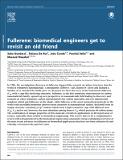Fullerene: biomedical engineers get to revisit an old friend
Author(s)
Goodarzi, Saba; Da Ros, Tatiana; Sefat, Farshid; Mozafari, Masoud; Osorio De Castro Conde, Joao
Download1-s2.0-S1369702116301808-main.pdf (2.218Mb)
PUBLISHER_CC
Publisher with Creative Commons License
Creative Commons Attribution
Terms of use
Metadata
Show full item recordAbstract
In 1985, the serendipitous discovery of fullerene triggered the research of carbon structures into the world of symmetric nanomaterials. Consequently, Robert F. Curl, Harold W. Kroto and Richard E. Smalley were awarded the Noble prize in chemistry for their discovery of the buckminsterfullerene (C[subscript 60] with a cage-like fused-ring structure). Fullerene, as the first symmetric nanostructure in carbon nanomaterials family, opened up new perspectives in nanomaterials field leading to discovery and research on other symmetric carbon nanomaterials like carbon nanotubes and two-dimensional graphene which put fullerenes in the shade, while fullerene as the most symmetrical molecule in the world with incredible properties deserves more attention in nanomaterials studies. Buckyball with its unique structure consisting of sp[superscript 2] carbons which form a high symmetric cage with different sizes (C[subscript 60], C[subscript 70] and so on); however, the most abundant among them is C[subscript 60] which possesses 60 carbon atoms. The combination of unique properties of this molecule extends its applications in divergent areas of science, especially those related to biomedical engineering. This review aims to be a comprehensive review with a broad interest to the biomedical engineering community, being a substantial overview of the most recent advances on fullerenes in biomedical applications that have not been exhaustively and critically reviewed in the past few years.
Date issued
2017-10Department
Institute for Medical Engineering and Science; Harvard University--MIT Division of Health Sciences and TechnologyJournal
Materials Today
Publisher
Elsevier
Citation
Goodarzi, Saba, et al. “Fullerene: Biomedical Engineers Get to Revisit an Old Friend.” Materials Today, vol. 20, no. 8, Oct. 2017, pp. 460–80.
Version: Final published version
ISSN
1369-7021
